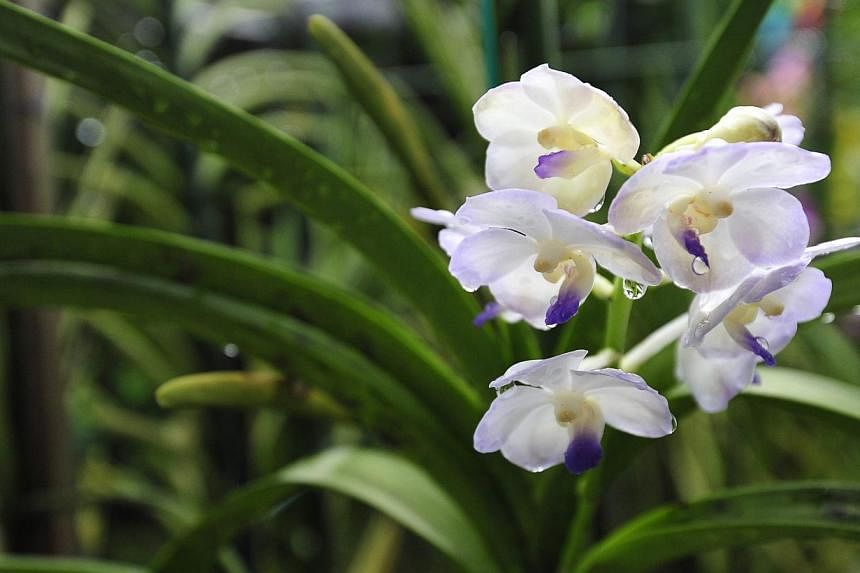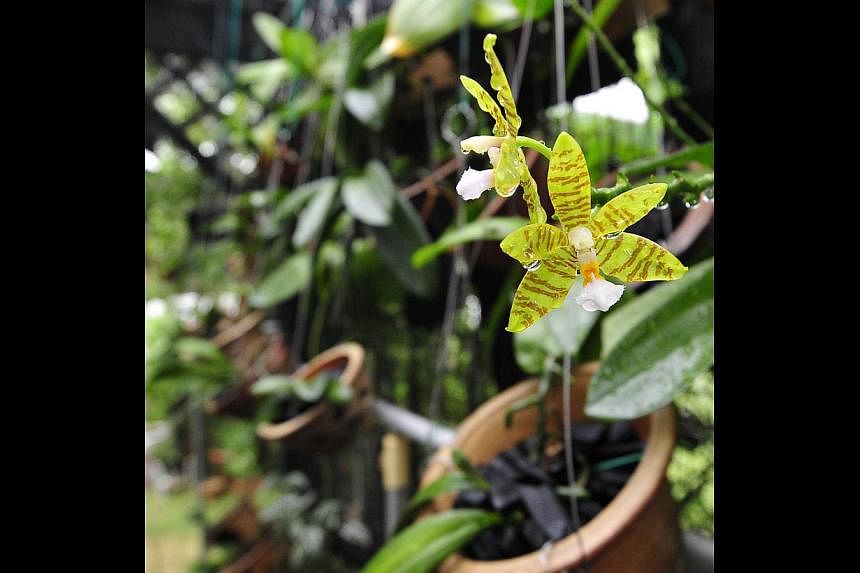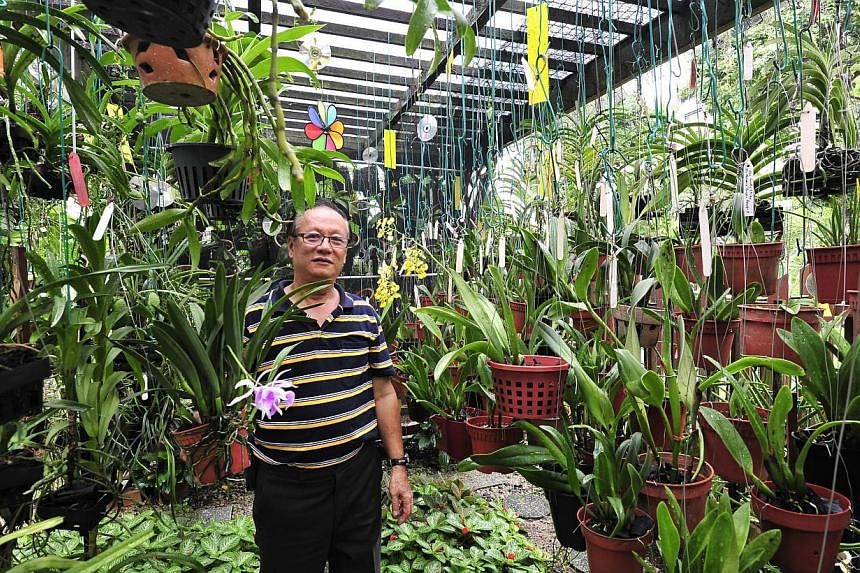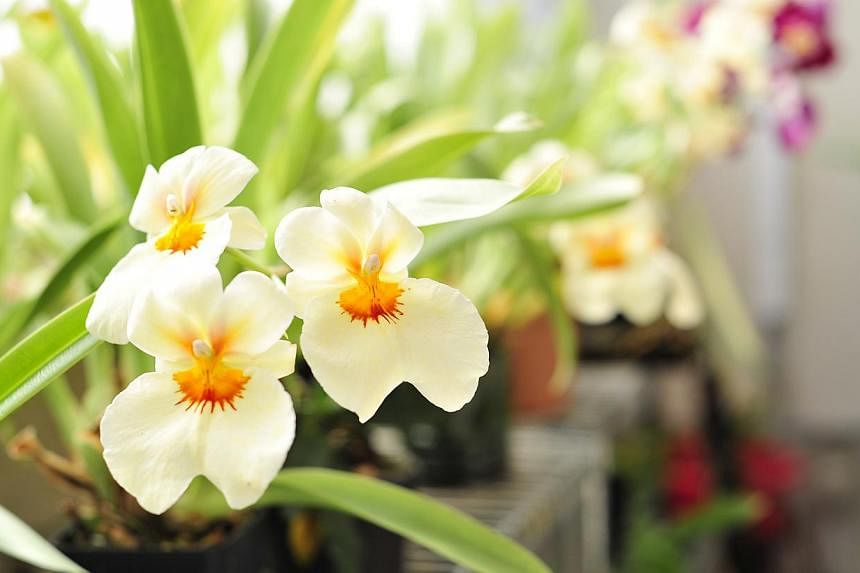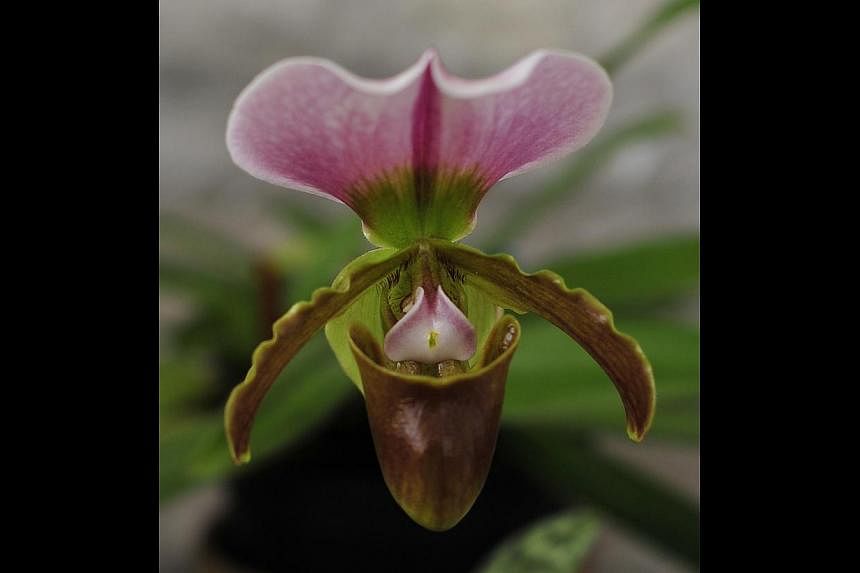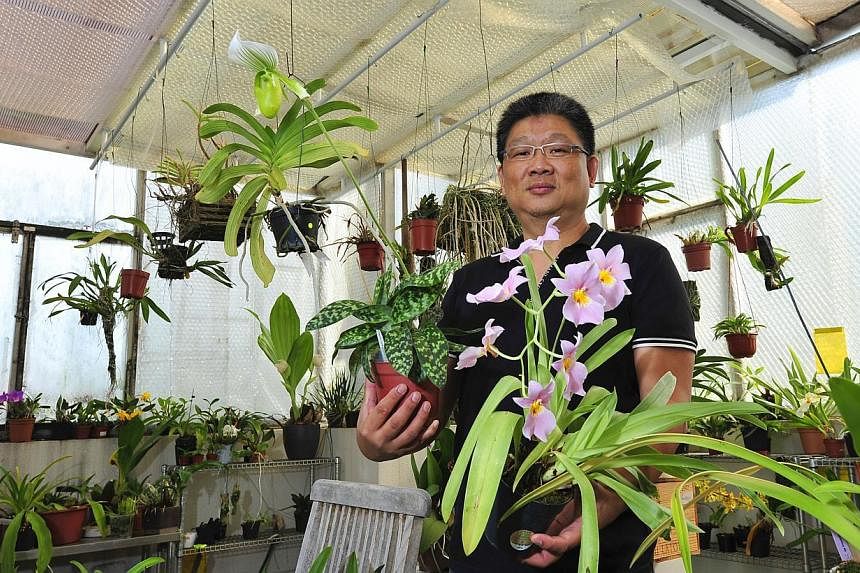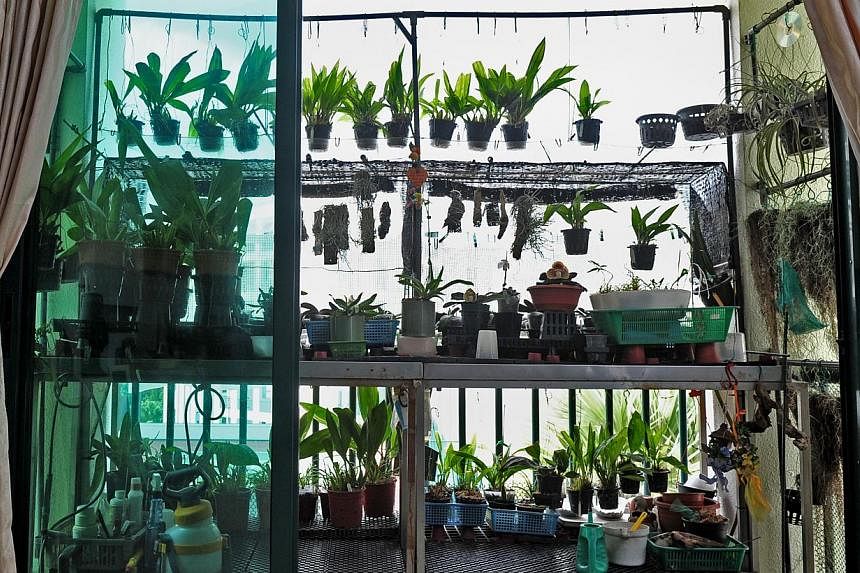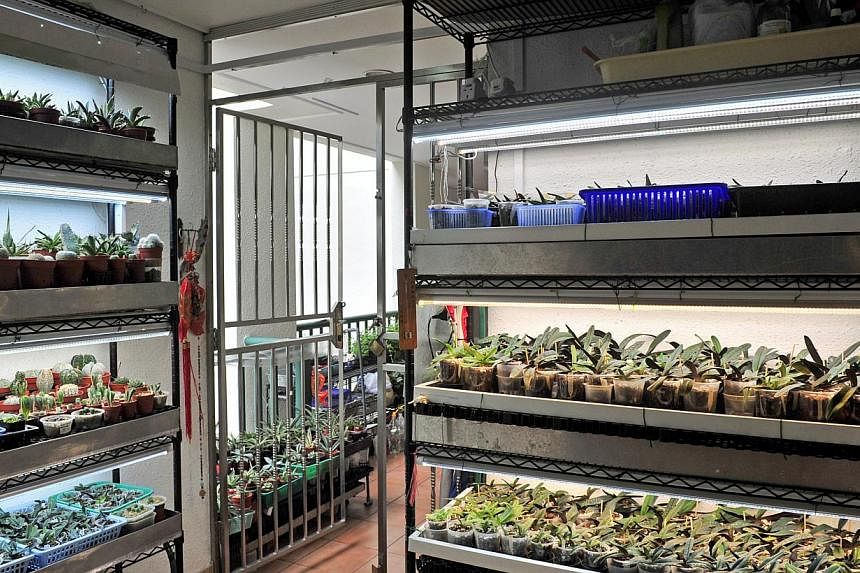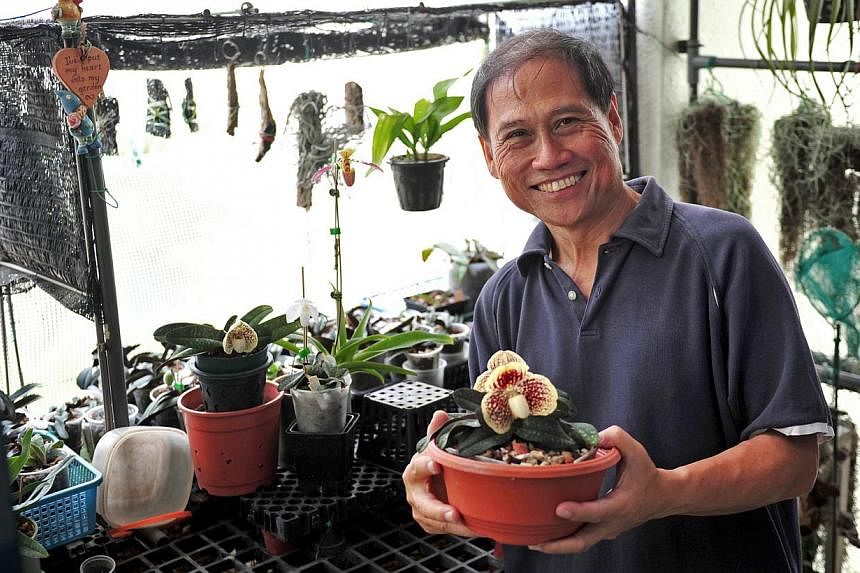Some orchids, notoriously finicky plants to grow in Singapore's tropical weather, can be a source of frustration for those who try to breed them.
Besides taking years to flower, they also require delicate care, such as making sure they get the right amount of sunlight, water and growing medium.
While some people might be put off by the tedious effort, orchid enthusiasts here have found ways to ensure the plant thrives and some have even cultivated rare species.
Life! talks to three orchid gardeners, who are members of The Orchid Society of South-East Asia (Ossea) here, to find out the secrets behind their success.
What are your experiences growing orchids? E-mail stlife@sph.com.sg
Orchids are his 'daughters'
Orchid hobbyist Joseph Yeo proudly shows off the results of his latest germination effort: Seedlings, with spindly stems, are growing in a black agar-agar base which has been injected with nutrients. They are placed in clear plastic bags, awaiting their transfer to pots.
Cultivating the tissue culture of orchids from ripe seed pods sounds like a complex science experiment, but Mr Yeo, a semi-retired operations supervisor in a petrochemical company who lives in a condominium apartment in the west, does it to make the most of his orchid seedlings.
He approaches the Agri-Food & Veterinary Authority of Singapore (AVA) to help him with this "orchid in-vitro germination". AVA charges $14 a pod for seed germination. It also does seedling production, charging $10 for every lot of 50 seedlings.
Mr Yeo, 60, says: "It's difficult to germinate at home as we do not have the micro-organisms that occur in the nature to help in the process."
There are shelves of orchid pots outside his front door. Rows of slipper orchids, bucket orchids and leafless orchids are placed under LED lights to aid photosynthesis, while adult orchids are hung in the balcony to get sunlight. In all, he has about 600 pots of orchids around the apartment.
Mr Yeo, who is married to a part-time English teacher with whom he has two adult sons, says: "My wife says I'm obsessed with orchids, but I'm just really passionate about finding out how they grow."
He started growing orchids in 2006 after he saw two pots of slipper orchids at a friend's house. They were in bloom and he was intrigued by how they were grown. He was growing nepenthes or tropical pitcher plants then.
"When I started gardening, I had no interest in growing orchids. But after seeing those orchids, I wanted the challenge of growing them. I thought I would have a good chance of making them flower."
A common mistake orchid growers make is not understanding the "micro-climate" that orchids need, he says. "You must choose orchids that suit your home and how much sunlight you get there. It's not about growing what you like."
He has clinched awards handed out by The Orchid Society of South-East Asia, but says he does not grow orchids to win prizes. Instead, he derives satisfaction from breeding an orchid successfully.
"If it's the first flower and it's exceptionally good quality, then it makes me very happy," says Mr Yeo, who once got a Paphiopedilum godefroyae with mostly black petals and sepal to bloom.
Mr Yeo, who nicknamed the flower Blacky, says: "When I saw that flower, I knew it was special because cultivar like this is rare and can occur one in several thousand plants."
He likens his hobby of growing orchids to keeping pets, and says the same amount of effort is required to care for them. For example, he wakes up at 5am twice a week to water and fertilise all his orchids and check on their growth.
$20,000 cold room for orchids
The discovery of the Phragmipedium kovachii in 2002 was heralded by orchid enthusiasts as the most amazing orchid find in the last century.
In May that year, nursery owner Michael Kovach in the American state of Virginia bought the majestic-looking purple bloom from a roadside stall in Peru.
Twelve years on, Singaporean David Ng has made waves too. He says he is the first person here to make the elusive slipper orchid bloom - twice. He bought its seedlings online in 2009 from Piping Rock Orchids, one of two sellers in the world then who were licensed to sell the flower.
Mr Ng, 50, a financial services director, says: "It took me five years to get the plant to flower. It's an achievement because of how rare the orchid is and how long it takes to flower." His flower wowed members of The Orchid Society of South-East Asia here, after he showed them pictures, and a few of them went to his home to snap photos of it.
He has also had luck growing the Paphiopedilum sanderianum with just a stump of its leaf and a root, which he got from an orchid farmer in Seremban, Malaysia, in 2010. This critically endangered plant, found only in Borneo, flowered last month.
Mr Ng loves his orchids so much, he has built a cold room for them in his semi- detached house in Seletar. He is married to Jolene, 50, a financial services consultant, and they have three children aged 16 to 21.
He caught the orchid-growing bug in 2008 when a friend gave him a purple phalaenopsis, a common moth orchid. Mr Ng, who was never a gardener before that, kept the plant until the flower withered.
He threw the plant into an empty plot next to his house, thinking it would not flower again. But it had piqued his curiosity, so he went to a shop to buy another. "I told the shop owner about my experience. He said with the right care, the orchid can bloom again. I thought I could revive the one I had thrown away, so I climbed over the fence to get it back," recalls Mr Ng.
True enough, he restored it to health.
That sparked off an orchid craze for Mr Ng, who started collecting paphiopedilums after he saw the flower in Bangkok's Chatuchak market. This is the genus of flowers which he collects the most.
He began buying flowers, at about $20 to $30 a pop, while trawling the Web for buyers who could ship seedlings to Singapore. He now grows about 200 orchids.
The $20,000 cold room on his rooftop, which measures about 6m by 4m, has bubble wrap around it for thermal insulation while letting in partial sunlight. There are three air-conditioning units and three fans to keep the temperature between 24 and 26 deg C. Mr Ng pays about $150 a month to maintain the room, on top of his monthly $1,000 utilities bill.
He does not use chemical fertilisers or insecticides, preferring to care for the plants the natural way due to the enclosed space. "It's bad for health to breathe in these gases. The orchids can fight for survival, just like in the wild."
Plant doctor is in
Retired teacher Stanley Ang jokes that his terrace house in Sin Ming Avenue is a "nursing home for orchids". The 66-year- old often receives orchids after festive periods, when those who own the plants want to throw them away as the flowers have wilted and no longer stand pretty.
Mr Ang, who used to teach mathematics at Ahmad Ibrahim Secondary School, says: "I get requests after the festive season to take in the orchids. So I nurse them back to health and return them to their owners."
In 1993, he erected a tent in his backyard to start growing orchids. Most of the space in his garden is now used to grow them. His wife, retired teacher Cecilia, 66, also grows a few cacti there, and tends the fruit trees and vegetables. The couple have two children, who are in their 30s.
The orchid "doctor" has had much experience with the fragile blooms. As a teenager, he used to grow them in cans after picking up discarded orchids.
Today, he looks after 700 orchids, such as those of the Vanda, Cattleya, Dendrobium, Catesetum and Oncidium species and hybrids. They are planted in pots and some are displayed in a tiered format.
Others are mounted on driftwood and fern bark, while he makes use of his four frangipani trees to hang orchids on their branches. After a few months, the epiphyte plant will latch onto its host tree and start growing around it.
Having a green thumb, says Ms Ang, is "in your blood"."I have loved nature and gardening since I was a young boy. The secret is to have love and patience because it's a challenge to grow orchids. Every time they bloom, you want them to have better flowers than the last time, so you really have to work at it."
One major challenge is the hot, muggy Singapore weather. Mr Ang says orchids are often "shocked" if they are brought over from a cooler climate and need time to recover.
He places the roots among charcoal pieces, a growing medium he finds ideal as it helps anchor the plant and ensures that it does not move too much - something which the orchids do not like.
He adds: "You must expose them slowly to the climate here. I experiment by placing the orchids at different spots in the garden. There can't be too much rain or sunlight. You have to watch how they react to these things and move them around to find the best spot."
He has also had to deal with pests. Bulbul birds often nip at the buds and flowers of the orchids, trying to find caterpillars to feed on, but end up destroying the plants.
"I've tried everything from putting compact discs to create light reflections to hanging black plastic eagles to scare them off," says Mr Ang, who eventually found that multi-coloured flower pinwheels are the most effective.
He encourages those who are interested in growing orchids not to be put off by the initial cost. When he started in the early 1990s, he used to buy about five plants every month - they can go for as much as $50 - but now exchanges plants with fellow hobbyists.
Mr Ang, who gives tours at the National Orchid Garden every third Saturday of each month, says: "When you start out, there's a lot of experimentation and you will end up killing a few. You have to start small and not be greedy and try and buy all the orchids that you see."
